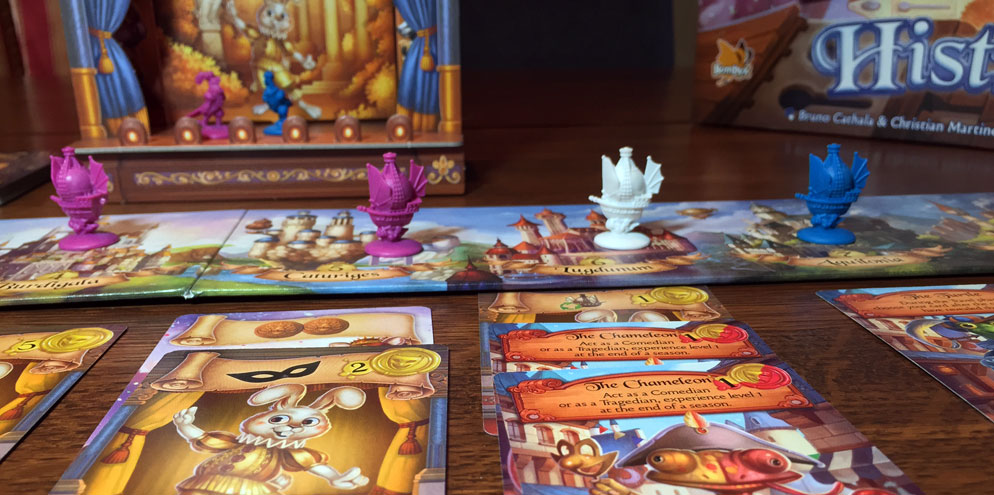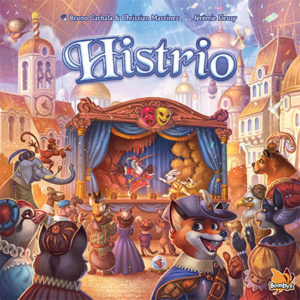 According to the dictionary, and by dictionary I mean my quick google search, Histrio is another word for “Actor”. To be honest, I thought it was a history buff or something. TIL…
According to the dictionary, and by dictionary I mean my quick google search, Histrio is another word for “Actor”. To be honest, I thought it was a history buff or something. TIL…
But after playing Histrio, a new game designed by Bruno Cathala (Five Tribes, Abyss) and Christian Martinez, the synonym makes sense. Published by Bombyx and Asmodee Games, Histrio is a new game that has players running an acting troupe while trying to put on a show that will please his royal majesty, The King, during the Munificent Theatrical Festival. With an award winning designer and some great looking components, I had high hopes for Histrio. Did it deliver? Time to find out!
Histrio is an action programming and set collection game for 2-5 players that takes about 45 minutes to play. In our experience, Histrio plays best with 3-4 players.
Game Overview:
In Histrio, players are running an acting troupe during the Renaissance. During the game, players will gather both actors and acrobats in hopes of putting on the most impressive play. However His Royal Majesty is a fickle man, and his mood might change as to what kind of play he would like to see.
As the season progresses, you’ll be traveling to different cities trying to recruit the best talent for your troupe. But if too many people vie for the actor’s attention, they won’t join up with anyone, and will instead opt to alter the king’s mood on their own.
If, at the end of the season you’ve recruited wisely, you’ll earn enough money to make you the richest acting troupe in the land. Once two seasons have been completed, the richest player is the winner.
Game Components:
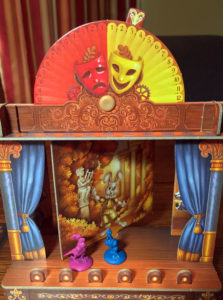
If you’ve ever played a game published by Asmodee, you know they don’t skimp when it comes to components and artwork. The main attraction in Histrio is the 3D stage. Once assembled, the stage will be used to track and show the kings mood. At the top of the stage is a slider that will adjust as the game progresses. If the King ever changes his mind and the mood slider goes from comedy to tragedy (or vice versa), the backdrop on the stage will spine around to match his current preference. I’ll be honest, this component is pretty awesome. It looks great and will definitely get someone’s attention.
Moving on, each player will has a hand of 8 travel cards, 8 Caravels, and 3 Managers. The travel cards, identically for all players, each depict one of the game’s 8 cities. The artwork on the travel cards, in the whole game really, is very well done and highly thematic.
The game also comes with 48 encounter cards comprised of actors and acrobats. Actors are used in your troupe to put on the play. Each actor will specialize in comedy or tragedy; have a skill level, and sometimes a special ability. Acrobats won’t help you with your play, but do impart a powerful special ability that can be used once per season.
Finally, the game comes with a pile of gold, silver, and copper plastic coins, called Ecus. The goal of the game is to collect as many of these as possible.
How to Play:
To begin the game, the King’s mood is randomly chosen and the stage backdrop is set accordingly. Then, an encounter card is dealt face up in-front of each city spot.
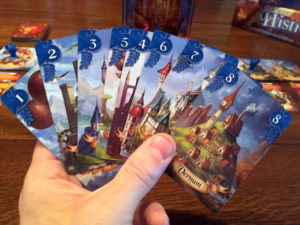
Histrio is played over two seasons, each of which is made up multiple turns. Each turn has 3 phases:
1. Travel: Each player secretly selects one of their location cards and places it face down in front of them. Once everyone has chosen, the cards are revealed and each player places a Caravel in front of the location the selected.
2. Resolution: During the resolution phase, each location with a Caravel next to it is checked and one of two things can happen:
- A player is alone at the location: They collect all the cards there. Each card is resolved one at a time (from the newest card to the oldest) and placed face up in front of the player. Some cards will have actions, such as granting a player money, letting them place a manager, refreshing their location cards, or letting them steal a coin. As a player collects their actors, they may optionally choose to discard one of them to alter the king’s mood in that specific direction.
- Two or more players are at the same location: The cards are discarded. Any actor cards will adjust the king’s mood based on their specialty and level. Players also get to draw a secret request card. One of these can be revealed at the end of the season to earn bonus money.
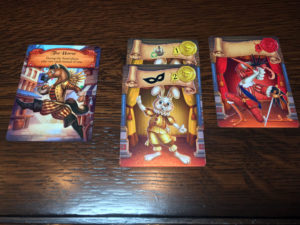
3. New Opportunities: If the encounter deck is empty, the season ends. If not, deal out 8 more cards to the city spaces again. This will most likely result in some cities having more than one card to collect if a player visits that location.
At the end of the season, players earn money for their acting troupe. A player will earn 1 coin for each actor that matches the King’s mood. They will also earn 3 coins (5 in season 2) if their play pleases the king. This means that the total difference in experience levels between their comedians and tragedians is positive according to the king’s mood. Whichever player has the largest positive margin earns double the reward. Players may also earn bonus coins from a secret request card.
After two full seasons, the player with the most money is the winner.
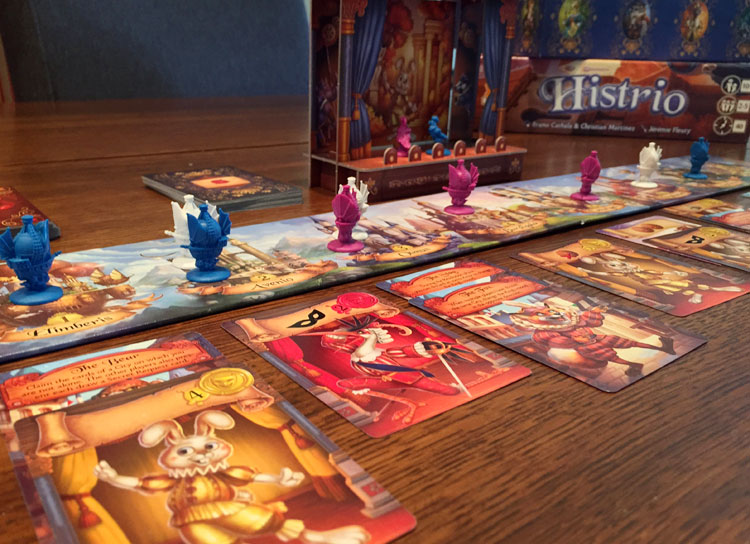
Game Experience:
I am a pretty big fan of some of Bruno Cathala’s games. From the award winning 5 Tribes, to BGQ favorite Abyss, Bruno’s designs make their way to our tabletops quite often. So when I saw his name on the box for Histrio, I was pretty excited to check it out.
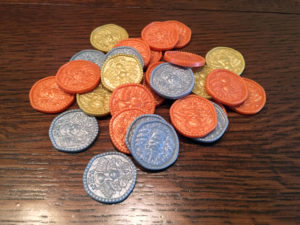
The first thing you are going to notice about Histrio is its fantastic components. As mentioned in the components section, Asmodee went all out with this one. I really enjoyed the 3D stage and how the backdrop rotates. Not only is it useful for showing the King’s mood, but when you spin it, it knocks the managers off the stage. Since managers are returned when the play type changes, this worked out really well. And for some reason, this method of clearing the stage entertained my inner child.
As for the actual game play, Histrio’s rules are fairly easy to learn, but the actual strategy can be surprisingly deep. During the selection phase, there is almost a psychological aspect to the game as you must try and not only figure out the best location for you to visit, but also try and guess where your opponents are headed.
This is because you always want to be placed at a location by yourself. Obviously the locations with multiple cards are the most enticing. But if two players select that location, no one gets anything. I really enjoyed the game of cat and mouse that was played here. I would sometimes visit a location I knew my opponent coveted to try and block him from getting the card he needed.
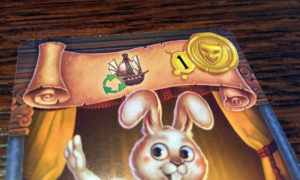
The downside of the location rules is that you can really end up getting hosed with some bad luck. Players don’t refresh their hands until they have played 7 of their 8 cards. The only way to refresh them earlier is to grab a level 1 actor. In one game, a player really needed a hand refresh but got blocked the two chances they had to grab the actor. The means that the last two rounds of the game, they had to go to sub-optimal locations because that’s all that was available to them. Needless to say, they lost. It’s times like this when the hand refresh mechanic can be somewhat punishing.
I found that Histrio gets pretty interesting when you are able to grab those multiple card piles. Sometimes you’ll get a great acrobat that gives you a really cool special ability. But the tough decisions come when you get more than one actor. You have to decide if you want to discard one of the opposing colors to keep your score high. But when you do, that disgruntled actor goes and adjusts the king’s mood. If too many players do that, the king will flip-flop, possible leaving you with a pile of unworthy actors. It’s these kinds of tough decisions that can make Histrio a lot of fun.
On the other hand, a fun strategy is to go heavy on the unwanted colored actors to try and build up a lead, then grab them to switch the king’s mood to your favor. I like that even in a game with so few rules, there are a few different approaches you can take to win the game.
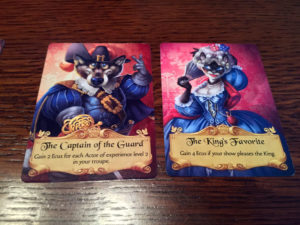
When it comes to player scaling, Histrio definitely plays best with 3-4 players. At 5 players, the competition for the locations gets a bit too fierce. You have a much greater chance of being stuck at a spot with someone else. The two player version of the game is a variant that uses 2 dummy players. While not perfect, this version actually worked okay. In general I’m not much of a fan of dummy players, but it works out well in Histrio. Although I’d still rather play with 3-4 players and doubt I’ll reach for Histrio too often with only 2 players.
Final Thoughts:
Bruno Cathala did a lot of things right with Histro and created an engaging game that’s simple to play, yet has a decent amount of depth. I really enjoyed trying to read my opponents when deciding where I was going to play my cards. Having 8 different locations really keeps a player’s options open and leaves a lot of room for your personal strategy. This is doubly so as the game progresses and the locations start to build up with cards.
Other than the player scaling, I don’t have very many complaints about Histro. The components are great, the game play is unique and engaging, and the play time feels pretty spot on. If you are a fan of Bruno Cathala’s eurogames, then Histrio should be on your radar to check out.
If you’d like to pick up a copy of Histrio, you can get it for about $50.
Final Score: 4 Stars – A fun and unique eurogame that’s easy to learn, yet has a good amount of depth.
 Hits:
Hits:
• Amazing Components
• Easy to learn rules
• Good player interaction
• Trying to read your opponents is fun
Misses:
• Game doesn’t play the best with 2 or 5
• The hand refresh mechanic can be punishing with bad luck







